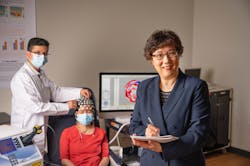Dual-mode brain sensing device could detect Alzheimer’s quicker
Alzheimer’s affects millions of people worldwide, yet it remains one of the most puzzling diseases. It materializes in the brain, sometimes progressing rapidly even before any behavioral signs or symptoms are discovered.
Recent developments show it’s possible to detect it faster and more effectively. A team led by the University of Texas at Arlington (UTA) is working on a dual-mode brain sensing device that can detect the disease quickly and noninvasively. Funded by a grant from the National Institutes of Health, the new technology uses broadband near-infrared spectroscopy (bbNIRS)—a noninvasive technology that can quantify metabolic, neurovascular, or hemodynamic functions and activities in the human brain. It’s based on the absorption and emission of near-IR light through the cortex, and pairs with multichannel scalp electroencephalograms (EEGs), which can provide quantitative mapping of electrophysiological activities in the human brain (see video).
“For the last two years, we have worked to develop novel devices and data analysis algorithms that enable us to quantify brain tissue’s optical properties using a combination of optical headband and dry EEG systems concurrently,” says Hanli Liu, a professor of bioengineering at UTA and the principal investigator of this work.
With bbNIRS, changes in cerebral concentrations of oxidized cytochrome-c-oxidase (oxCcO), oxygenated hemoglobin (HbO), and total hemoglobin (HbT) in the human forehead in vivo can be quantified with excellent reproducibility and reliability, she says, adding that CcO facilitates the utilization of oxygen for cellular energy metabolism.
As oxygenated blood in the brain reflects vascular physiology and hemodynamic conditions, and thus are closely associated with brain health. Neurophysiology-based parameters such as cerebral oxCcO, HbO, and HbT can be altered or deteriorated in the human brain with Alzheimer’s compared to that of normal aging adults. Liu notes that researchers have found bbNIRS in vivo is able to distinguish patients with the disease vs. age-matched controls.
Currently methods for detecting Alzheimer’s rely on MRI and PET scanning to see and assess behaviors. But these techniques are not as comprehensive when it comes to identifying symptoms, particularly in the early stages.
“The weaknesses of behavioral assessments include being non-quantitative and non-sensitive for early detection,” Liu says. “It is common that patients with early-stage Alzheimer’s would not show any behavioral signs or symptoms.”
Since the Alzheimer’s brain forms significant degenerations in all anatomical, biological, and pathological aspects, such deteriorations must be accompanied by cerebral dysfunctions of metabolic, hemodynamic, and electrophysiological (MHE) activities.
“Our dual-mode system is a high-risk, high-impact, proof-of-principle approach to demonstrate that noninvasive measurements of brain tissue spectroscopy can contain key information of neurophysiological signatures,” Liu says.
These signatures can serve as digital biomarkers to identify and cross-validate. They’re also used for accurate detection of Alzheimer’s patients at different severity levels. With the new device, the researchers will be able to identify neurophysiological biomarkers that can ultimately be used in screening for Alzheimer’s for earlier, more rapid, and more accurate detection at mild or moderate-to-severe stages.
The team expects their study will allow identification of critical digital biomarkers for early detection of Alzheimer’s at various stages. And the new technology could, theoretically, someday be applied to other diseases in the brain.
“The success of the study will permit us to pursue a larger clinical trial that will validate and promote digital biomarkers for early, rapid, low-cost, and accurate identification of the disease,” Liu says, noting that early detection is key to effective treatment.

Justine Murphy | Multimedia Director, Digital Infrastructure
Justine Murphy is the multimedia director for Endeavor Business Media's Digital Infrastructure Group. She is a multiple award-winning writer and editor with more 20 years of experience in newspaper publishing as well as public relations, marketing, and communications. For nearly 10 years, she has covered all facets of the optics and photonics industry as an editor, writer, web news anchor, and podcast host for an internationally reaching magazine publishing company. Her work has earned accolades from the New England Press Association as well as the SIIA/Jesse H. Neal Awards. She received a B.A. from the Massachusetts College of Liberal Arts.
